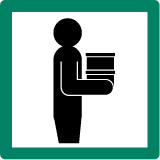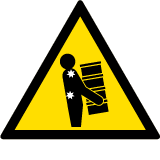One look at the skull-and-crossbones on a container and most people know they are in the presence of poison. This speaks to the power of visual symbols to effectively and quickly convey hazard information to workers.
The Institute for Work & Health (IWH) is taking part in an exciting project led by Safe Workplace Promotion Services Ontario (SWPSO), one of four newly amalgamated health and safety associations. (The Ontario Service Safety Alliance [OSSA], the Industrial Accident Prevention Association [IAPA] and the Farm Safety Association joined together last year to form the SWPSO).

Moving prepped food to the cooking area
The project’s aim is to broaden the use of such visual symbols — called pictograms — within the health and safety context. First up: pictograms to convey musculoskeletal injury hazards in the restaurant sector. And that’s just the beginning.
Kim Grant is in research and product development at SWPSO. She explains that the project got its start when OSSA submitted a 2008 budget request to the Workplace Safety and Insurance Board (WSIB) to develop visual learning within the service sector. “The WSIB provided important financial support to develop pictograms throughout the Ontario health and safety prevention system,” she says. With the funding, the scope of the project was extended.
A committee is overseeing the project, and includes representatives from SWPSO, WSIB, and the Ontario Ministry of Labour. It also includes IWH Scientific Director Dr. Ben Amick. We’re here to ensure the reliability of the research and evaluation components of pictogram development,
says Amick.
Based on an IWH review team’s search of the scientific literature on what makes pictograms effective, and adopting visual symbol standards set out by the Canadian Standards Association (CSA), the committee commissioned the development of pictograms to address five leading hazards in restaurant kitchens. Pictograms were commissioned to not only identify the hazards, but also show how to work safely in the face of each hazard.
We are doing something that has not been done before in Ontario,
says Grant. We are linking hazard pictograms with control pictograms. This is ground-breaking.

Moving prepped food to the cooking area
Focus groups, designed and run with IWH assistance, were held to reach consensus on the most effective pictogram for each hazard. These versions are now being implemented and evaluated in real workplaces, again with the help of IWH.
Kinesiologist Trevor King, a research coordinator at IWH, is playing a key role in the onsite testing of the pictograms. We are trying to reach 100 employees in about eight restaurant sites,
he says. The pilot testing includes employee and supervisor training, before-and-after assessments to see if the pictograms result in behavioural changes, and control and intervention groups to ensure other factors aren’t responsible for any identified changes.
Guidelines will help others create pictograms
Much more is coming from this project. Pictograms are in the works for retail, farm, and slip, trip and fall hazards. Most important, two guidelines are being written, one on how to develop pictograms and another on how to evaluate them. We are keeping track of our experiences and lessons learned,
says Grant. The resulting guidelines can be used by any part of the Ontario health and safety system to develop pictograms for workplaces.
Grant admits that developing and evaluating pictograms is not easy. Like many other groups, we’re finding out that it’s really difficult,
she says. But we’re going to stick with it so we are confident in the recommendations we make to others. We want to be best in class and create a platform from which other people can successfully launch.